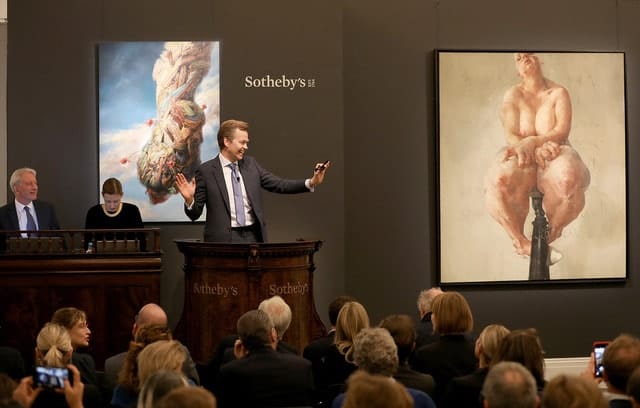Articles and Features
The Challenges
Facing the Art World Today

“Art should dismantle consensus, not collude towards it.”


by Sylvain Levy
Sylvain Levy is a collector and, along with his wife Dominique, is one of the principals of the dslcollection, a major collection of Chinese contemporary art. Founded in 2005, the dslcollection promotes the discovery and study of Chinese contemporary artistic production. It embraces innovative technologies in order to foster greater visibility and to provide the means to share the experience of contemporary culture. Openness, the nomadic and sharing are core concepts of the dslcollection.
I was in London a few days ago where I had an enlightening discussion with the students of Sotheby’s Institute on the challenges facing today’s art world. Here are the key takeaway points:
The most challenging problem facing the art world today may be the conflict between the new global audience of visually fluent people versus the traditional art-world elites. Could a small group of influential people leading the major museums, galleries, auction houses, and art publications continue to define which artists would be celebrated? Avoid the tyranny of consensus. Art should dismantle consensus, not collude towards it. Unfortunately though, today’s values arise from consensus and art is preposterously overvalued (at least monetarily).
Another challenging issue is the power of money in the art world. The international art world faces the same threats as all economic systems that dominate our globe; wealth is concentrated at the top, being traded by the select few, with little trickling down to the source, to the artists who produce the works, to the writers, curators and non-profit organizations who play vital roles in the art ecosystem.
The disappearance of a truly critical apparatus is another problem. With few notable exceptions, art criticism is rarely critical and sadly it has been that way for a while. What happens when artists, emerging far from the critical consensus, leapfrog the entire gallery/museum/publication system, simply by attracting thousands of Instagram likes and legions of YouTube followers?
With the increasing professionalization of the art enterprise, there is also a disturbing tendency for art to become insular, focusing narrowly on the art world itself, rather than the immense societal, political and environmental challenges that we face on a daily basis.
“The greater the speed, the less time there is for careful thought, meaningful exchanges, slow research, and genuine pleasure in art.”
The structure of the art market and in particular, the balance between dealers and auction houses has changed dramatically in the last 25 years; and it continues to change every season, as does the competition between the vast network of auction houses themselves. The commodification of contemporary art, fuelled by auction houses is another topic that raises concern. Until about 1985, contemporary art had a very low resale potential. If a collector bought the latest work by a living artist, he could not expect to get much of his money back from its resale – like a new car. Now, many buyers buy contemporary art with the expectation that they can make quick money by “flipping” it – as long as they have “invested” in the right artist. This is a big change in the balance and the attitude of the art market. Is it “wrong” and does it need “fixing”? One of the consequences of quick turnover is the vast quantities of contemporary art constantly being “vomited” onto the market. That’s why we now have artists seeking their “one hit wonder”, coming up with yet another new trick/gimmick to satisfy the insatiable appetite of the audience.
One of the consequences of quick turnover is the vast quantities of contemporary art constantly being “vomited” onto the market. That’s why we now have artists seeking their “one hit wonder”, coming up with yet another new trick/gimmick to satisfy the insatiable appetite of the audience.
Another important issue is speed. Speed defines today’s art world—speed of travel, of electronic communications, of human contacts and professional transactions, of transfers of massive amounts of information and wealth, of proliferating art fairs and biennials as must-see art marketplaces. The greater the speed, the less time there is for careful thought, meaningful exchanges, slow research, and genuine pleasure in art. Speed shrinks the world and contributes to a culture of celebrity, as jet-setting curators hop around the world, trolling the same venues for the next global art star. It also greatly impacts creativity. We throw ourselves into a state of perpetual motion, forever shuttling from the newest museum’s opening to the next must-see biennial. Such vibrant development is great, but the accelerated pace places a tremendous pressure on artists to be in a constant state of creative production. However, real artists need time and space to fully develop, and the frenetic atmosphere tempts too many artists toward overproduction, with long-term risks for the quality of their work and the longevity of their careers.
Solutions? Should we slow down? Should we forget about money? Return to the good old days of leisurely studio visits and handwritten letters? Not bloody likely. These are some of the issues that we need to fix in the artworld today.
Relevant sources to learn more
About Artland x dslcollection collaboration
dslcollection column by Sylvain Levy: What is a Museum today?
dslcollection column by Sylvain Levy: The Virtual Museum
dslcollection profile
Visit the dslcollection